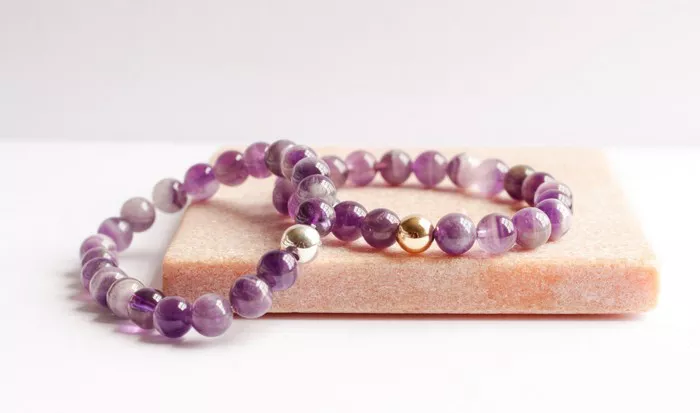Stone bracelets have long been cherished for their natural beauty, healing properties, and spiritual significance. Whether you’re purchasing a stone bracelet for its aesthetic appeal, metaphysical benefits, or as a valuable investment, distinguishing between genuine stones and imitations is crucial. This guide explores methods to identify real stone bracelets, factors influencing authenticity, and tips for ensuring you acquire a genuine piece that meets your expectations.
Understanding Stone Bracelets
Stone bracelets feature a variety of natural and synthetic materials, each with distinct characteristics and properties:
Natural Gemstones: These include minerals such as diamonds, rubies, sapphires, emeralds, and semi-precious stones like amethyst, turquoise, jade, and lapis lazuli. They form naturally within the Earth and exhibit unique colors, patterns, and inclusions.
Synthetic Gemstones: Created in laboratories, synthetic stones mimic the appearance and properties of natural gemstones. They are often used as affordable alternatives to natural stones or for specific color consistency.
Imitation Stones: These are made from glass, plastic, or other materials designed to resemble natural gemstones. Imitation stones are inexpensive and lack the physical properties and value of genuine gemstones.
Methods to Determine Authenticity
Identifying whether a stone bracelet is real involves a combination of visual inspection, testing methods, and knowledge of gemstone characteristics:
Visual Inspection:
Color and Clarity: Natural gemstones exhibit a range of colors, from vivid hues to subtle tones, depending on their type. Look for clarity and transparency, as natural stones may contain inclusions (internal flaws) or natural formations.
Surface Texture: Genuine gemstones have a distinct surface texture and may show signs of wear or polishing. Examine the bracelet under different lighting conditions to observe how light interacts with the stone’s surface.
Weight and Density: Natural gemstones have specific weights and densities that differ from imitations. Compare the weight of the bracelet to its size and the expected weight of the stone type.
Certification and Documentation:
Gemological Certificates: Genuine gemstones often come with certificates from reputable gemological laboratories such as GIA (Gemological Institute of America) or AGS (American Gem Society). These certificates provide details about the stone’s origin, quality grades (such as the 4Cs for diamonds), and any treatments applied.
Seller Documentation: Request documentation from the seller, including receipts, invoices, or warranties that verify the authenticity and quality of the stone bracelet.
Physical Tests and Measurements:
Hardness Test: Use a hardness testing tool like the Mohs scale to determine the hardness of the stone. Natural gemstones have specific hardness levels (e.g., diamonds are the hardest at 10 on the Mohs scale), while imitations and glass have lower hardness levels.
Magnification: Use a jeweler’s loupe or magnifying glass to examine the stone closely. Look for natural inclusions, growth patterns, and other internal features that indicate authenticity.
UV Light Test: Some gemstones exhibit fluorescence under ultraviolet (UV) light. Use a UV light source to observe any fluorescence, which can be a characteristic feature of certain gemstones like diamonds and some colored gems.
See Also: How Much is a Jade Bracelet Worth?
Characteristics of Popular Gemstones
Different types of gemstones have unique characteristics that aid in their identification:
Diamonds:
Hardness: Diamonds are the hardest natural substance and scratch-resistant.
Brilliance: Exceptional brilliance and fire due to their high refractive index.
Inclusions: Natural diamonds may contain inclusions like crystals, feathers, or clouds.
Rubies and Sapphires:
Color: Vivid red for rubies and various colors (excluding red) for sapphires.
Inclusions: Natural rubies and sapphires often have silk-like inclusions known as “silk.”
Emeralds:
Color: Deep green to bluish-green hues.
Inclusions: Natural emeralds typically have visible inclusions known as “jardin” (garden), which are internal fractures and mineral inclusions.
Amethyst:
Color: Purple to violet hues.
Clarity: Natural amethyst may contain visible inclusions or color zoning.
Tips for Authenticating Stone Bracelets
Follow these tips to ensure you’re purchasing an authentic stone bracelet:
Buy from Reputable Sources: Purchase from established jewelers, gemstone dealers, or reputable online retailers known for selling genuine gemstone jewelry.
Research and Compare: Research the characteristics and pricing of specific gemstones before making a purchase. Compare multiple sellers to ensure consistency in quality and pricing.
Ask Questions: Inquire about the stone’s origin, treatments, and any certifications or guarantees offered by the seller.
Inspect Packaging and Documentation: Examine the packaging and accompanying documentation for signs of authenticity, such as branded boxes, certificates, or warranty information.
Ethical and Environmental Considerations
When buying stone bracelets, consider ethical and environmental factors:
Ethical Sourcing: Support sellers who adhere to ethical sourcing practices and avoid conflict gemstones. Look for certifications like Kimberley Process Certification for diamonds.
Environmental Impact: Choose gemstones from sources committed to environmental sustainability and responsible mining practices.
Conclusion
Identifying whether a stone bracelet is real involves careful examination, knowledge of gemstone characteristics, and verification through reputable sources and documentation. By understanding the differences between natural gemstones, synthetic stones, and imitations, you can make an informed decision when purchasing or evaluating a stone bracelet. Whether for aesthetic pleasure, spiritual beliefs, or investment purposes, acquiring a genuine stone bracelet ensures you enjoy its beauty and intrinsic value with confidence. Embrace the journey of discovering and appreciating the unique qualities of natural gemstones, reflecting their timeless allure and enduring appeal in jewelry and personal adornment.

